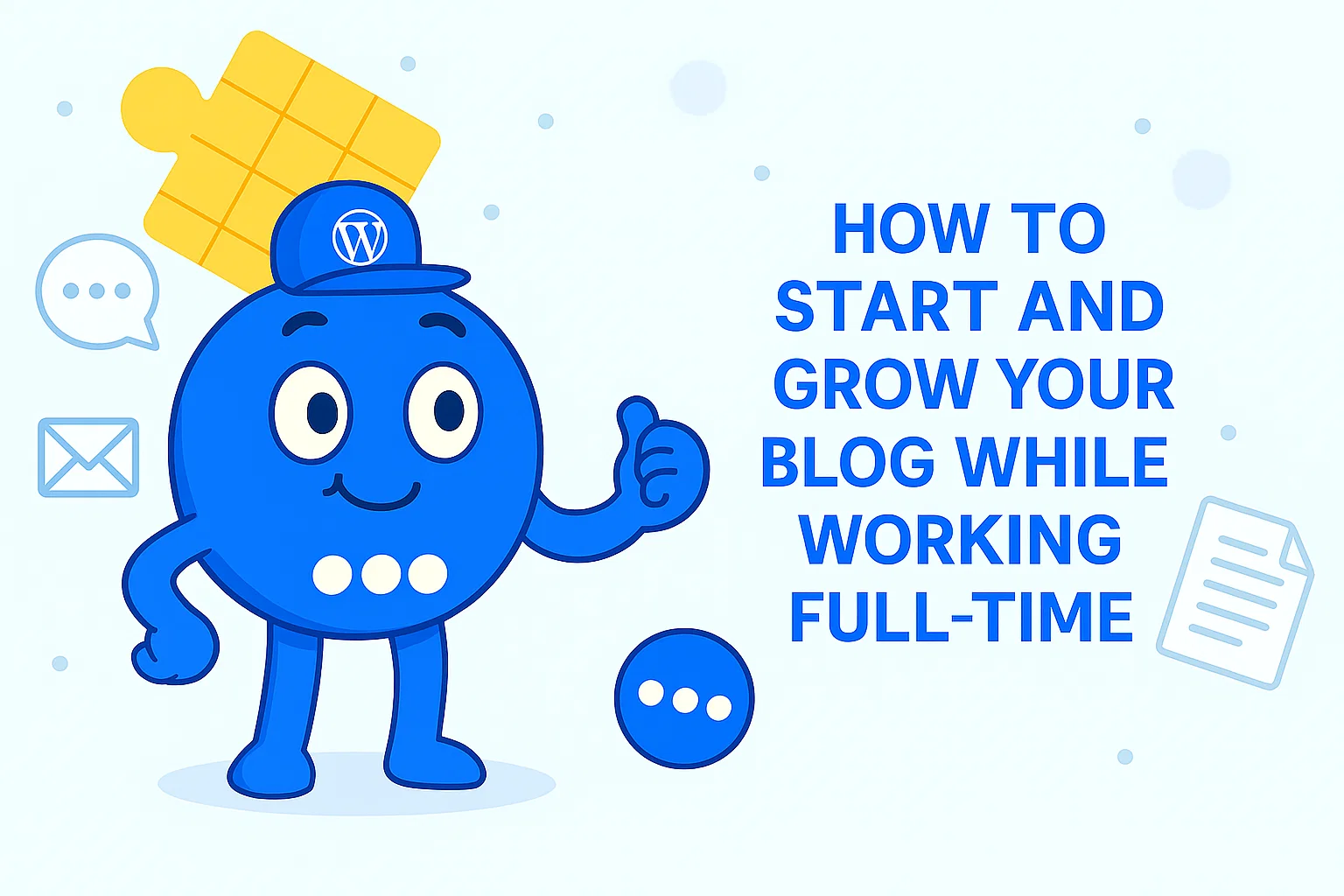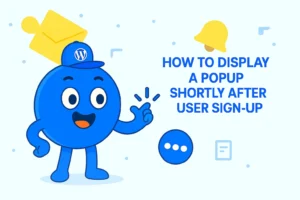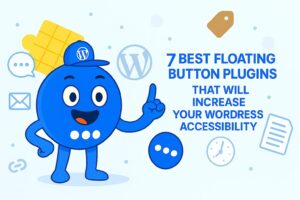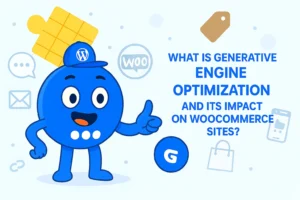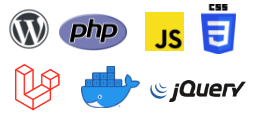How to Start and Grow Your Blog While Working Full-Time
I. Introduction: The Blogging Journey Begins
The prospect of launching and nurturing a blog while managing a full-time professional life can appear daunting. For many, the idea of adding another significant commitment to an already packed schedule might seem overwhelming.
However, for business owners, WooCommerce entrepreneurs, business affiliates, and other driven individuals, blogging is not merely a hobby; it represents a powerful strategic asset capable of establishing authority, attracting new customers, and cultivating sustainable income streams.
Consider, for a moment, the common challenges faced by an aspiring blogger: a feeling of being perpetually overwhelmed, struggling with inconsistent output, and observing minimal traction despite earnest efforts. This often leads to questions of whether the investment of time and energy is truly worthwhile.
Now, envision a transformed scenario: a blog that consistently draws in its ideal audience, generates valuable leads, and even produces revenue, all seamlessly integrated into a busy lifestyle. This guide is designed to illuminate the path to that transformation, providing actionable strategies for building a thriving online presence without sacrificing existing commitments.
Blogging, in essence, is a long-term investment that yields substantial dividends. It serves as a robust channel for building trust and credibility with an audience, effectively positioning the blogger as an expert in their chosen field. Furthermore, a well-maintained blog functions as an evergreen marketing asset, continually working to attract and engage potential customers over time.
II. Laying the Foundation: Strategic Setup for Success

Establishing a strong foundation is paramount for any blogging endeavor, particularly for those balancing it with a full-time career. This initial strategic setup ensures that efforts are directed toward meaningful growth and tangible results, preventing wasted time and resources.
Finding a Niche and Audience
Passion Meets Profit: How to Choose a Sustainable and Profitable Niche
When brainstorming blog niche ideas, a comprehensive approach considers industry-based topics, specific target audiences, or particular subjects. The most effective niches are those where the blogger possesses genuine passion, significant experience, and deep knowledge. This commitment to the subject matter is not merely a preference; it is a critical factor for long-term sustainability and consistency, especially when time is limited.
Furthermore, a profitable niche typically offers opportunities for monetization, such as through affiliate programs. Popular and often profitable niches include personal finance, health and fitness, technology, business, and travel. While researching existing competition is important, a strategic approach often involves narrowing the focus to a more specific sub-niche if the broader field is highly saturated.
For a new blogger, particularly one with limited time, attempting to compete in a broad, highly competitive niche can be an uphill battle. By focusing on a narrower area, such as “simple fitness routines for working parents” instead of general “fitness,” a blogger can more quickly establish expertise and authority within a smaller segment of the market.
This targeted approach attracts a highly specific and engaged audience, and it also allows for ranking for less competitive, long-tail keywords, leading to faster initial traffic and a stronger foundation for growth. This accelerated progress is often crucial for maintaining motivation for busy individuals.
A significant consideration, especially for new bloggers, involves avoiding Your Money Your Life (YMYL) niches, which include topics like medical, financial, or legal advice. Google places a high emphasis on verifiable credentials and established authority in these sensitive areas. For most, strategically avoiding these niches can save considerable time and effort, allowing for a more manageable and effective blogging journey.
Understanding Your Ideal Reader: Who Are You Talking To?
Before content creation begins, it is essential to define the target audience. This involves understanding their demographics, geographic location, interests, and professional background. Crucially, it also entails identifying the specific types of content they seek and the keywords they use to find it. Creating detailed buyer personas can provide deeper insights into their needs, pain points, and online behavior.
A core strategy for valuable content is to identify a problem that the target audience struggles with and then provide clear, actionable solutions. This problem-solving approach not only establishes the blogger’s expertise but also builds trust, which is foundational for future conversions.
Choosing a Platform
Why WordPress Is Often the Best Choice for Non-Technical Users
WordPress is widely recognized as a dominant platform for blogging, often referred to as “The Titan of Blogging Platforms“. It provides comprehensive control over the website, offers extensive scalability, and integrates robust SEO tools.
Many successful bloggers leverage WordPress and its vast ecosystem of plugins for both content creation and promotion. While WordPress is rated as “moderate” in terms of ease of use compared to some simpler alternatives , the initial learning curve is a worthwhile investment for business owners.
This platform offers the flexibility to grow, diversify monetization strategies , and adapt to future needs without the significant time and effort required for migrating platforms later. This foresight is critical for busy individuals aiming to build a long-term digital asset.
Essential Initial Content Planning
Brainstorming Evergreen Content Ideas That Solve Problems
Content planning begins with brainstorming topics relevant to the target audience and niche. A highly effective strategy is to focus on identifying problems that the target audience faces and then providing clear, actionable solutions. This approach not only makes the content valuable but also establishes expertise and builds trust, which are foundational for future conversions.
Content can take the form of lists of tips, tools, and techniques, often presented with scannable bullet points for easy digestion. Answering frequently asked questions within the industry or area of expertise is another effective method for generating helpful content.
Prioritizing “timeless” or “evergreen” topics, such as how-to guides, ultimate guides, and listicles, ensures that the content remains relevant and valuable over an extended period, providing continuous traffic and engagement. Offering additional resources like free tools, downloads, checklists, or video tutorials can further enhance value and serve as effective lead magnets.
Crafting a Unique Voice and Style
Developing a distinctive voice and writing style is paramount for creating content that connects deeply with readers. A conversational tone, where the blogger writes as if speaking directly to the reader using “you” and “your,” fosters a friendly and relatable experience. Incorporating contractions, interjections, and personal anecdotes can add a casualness that makes the writing feel more human and engaging.
Engaging readers with questions encourages active participation and deeper thought.
Beyond tone, it is vital to share genuine passion for the chosen topics, as enthusiasm shines through and inspires readers. Developing a unique angle or “spin” on popular subjects, perhaps by sharing an unconventional opinion or personal experience, helps the content stand out. Authenticity is a key differentiator in the digital landscape; readers can often detect inauthenticity, which erodes trust.
Furthermore, employing inclusive language is crucial. This involves avoiding gendered terms and problematic language, and defaulting to gender-neutral pronouns if unsure. For instance, using “everyone” or “y’all” instead of gendered greetings ensures that all readers feel acknowledged and respected.
This practice extends beyond ethical considerations; for business owners, it directly impacts audience reach and brand perception. By using language that is welcoming to all, a blogger broadens their potential audience, avoids alienating any segments, and cultivates a more trustworthy and relatable brand image. This subtle yet powerful choice can lead to higher engagement and a more loyal community.
III. Mastering Time: Blogging Smart, Not Hard

The primary challenge for individuals balancing a full-time job with blogging is effective time management. This section outlines strategies to maximize productivity without compromising existing responsibilities or risking burnout.
Time Management Strategies for the Full-Time Blogger
Batching Tasks for Maximum Efficiency
A highly effective strategy for busy bloggers is to batch related tasks together rather than constantly switching between different types of work. This approach minimizes context switching, the mental cost associated with shifting focus. For individuals with limited time, this constant mental reorientation can be a significant drain on energy and efficiency.
By dedicating specific blocks of time to a single type of task, such as writing multiple blog posts, filming several videos, or scheduling social media content for the week, a blogger can enter a “flow state” more easily. This leads to higher quality output and greater overall efficiency in less time. For instance, setting aside a few hours solely for writing or graphic design can yield more productive results than scattering these tasks throughout the week.
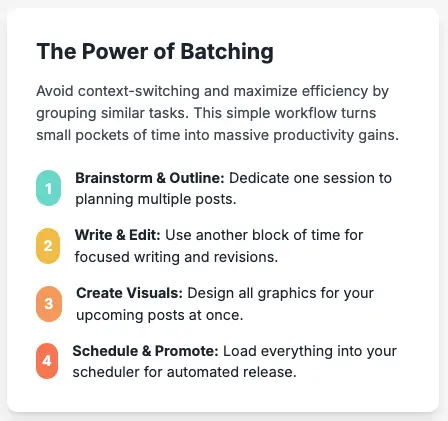
The Power of Consistent, Short Bursts of Work
Finding large, uninterrupted blocks of time for blogging is often impractical for those with full-time jobs. The strategy of working in short bursts, often facilitated by techniques like the Pomodoro Technique, directly addresses this challenge. The Pomodoro Technique involves breaking work into 25-minute focused periods, separated by 5-minute breaks.
This approach redefines productivity as a series of consistent, small wins rather than grand, time-consuming efforts. It is psychologically beneficial, preventing overwhelm and making blogging feel more achievable, thereby fostering crucial consistency.
Prioritizing and Setting Realistic, Sustainable Goals
To avoid spreading oneself too thin, it is crucial to treat blogging seriously, setting achievable and sustainable goals with clear deadlines. Instead of focusing on the sheer amount of time spent, a blogger might aim for concrete metrics, such as publishing “2 blog posts a week,” as a measure of progress.
Prioritization is key: identify tasks that genuinely add value to the blog and minimize or eliminate “time and soul-sucking tasks that don’t pay off“. For example, rather than attempting to maintain a presence on every social media platform, it is more effective to pick one or two channels and focus on excelling there.
This “less is more” philosophy is a critical growth strategy for busy individuals. By strategically limiting activities to a few high-impact areas (e.g., excellent content, focused social media, basic SEO), disproportionately better results can be achieved compared to attempting to do everything poorly. This approach emphasizes working smarter, not harder.
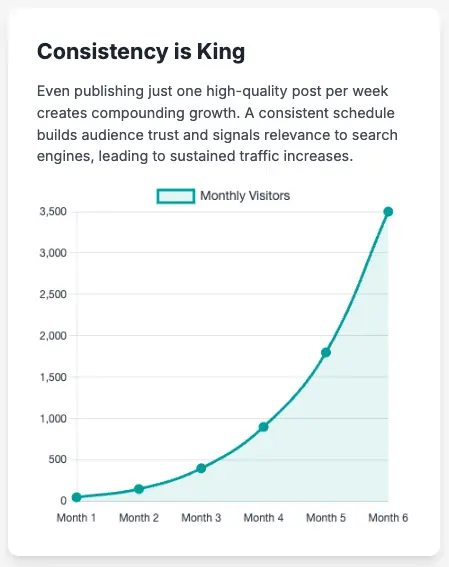
Minimizing Distractions and Leveraging Small Pockets of Time
Distractions can severely impede productivity. Strategies such as setting timers for social media scrolling can help minimize wasted time. Utilizing tools to streamline workflows is also essential.
- Project management tools like Asana can help manage blog posts and social media scheduling.
- Canva simplifies graphic creation, allowing for quick and easy design of images using templates.
- Scheduling posts ahead of time, a feature available on many platforms or through tools like Meta Business Suite, ensures consistency without constant active engagement.
- Time-blocking with tools like Google Calendar can help dedicate specific hours for blogging tasks, reinforcing a structured approach.
While these tools are often perceived as organizational aids, for a full-time blogger, they function as “time multipliers.” Automating scheduling, streamlining design processes, and centralizing tasks significantly reduce cognitive load and manual effort, freeing up valuable time for core activities like writing and strategic planning. This is particularly important when time is a scarce resource.
Building a Content Calendar
Mapping Out Content for Consistency
The process of building a content calendar begins with brainstorming a comprehensive list of topics and content types, including blog post ideas, video concepts, and social media content. Once ideas are generated, specific publication dates should be assigned, and content should be spread out to ensure a balanced mix of types and topics each week.
For busy individuals, consistency is often the biggest challenge in blogging. A content calendar transforms the abstract goal of “blogging regularly” into concrete, scheduled tasks. This pre-planning reduces decision fatigue and minimizes the likelihood of procrastination on busy days, thereby ensuring a steady output.
Consistent content creation is rewarded by search engines and builds audience expectation and loyalty. It serves as a proactive strategy against the reactive chaos often found in a busy professional life.
Leaving Room for Flexibility and Adaptation
While meticulous planning is crucial, a content calendar should not be rigid. It is important to build in flexibility to incorporate new ideas or swap out underperforming content. Regularly reviewing the calendar’s performance, ideally on a monthly basis, allows for adjustments based on what generates interest and what falls flat.
This agile approach to blogging means not being strictly bound by an initial plan but rather being responsive to audience feedback, performance data , and evolving industry trends. This iterative process ensures that limited time is continuously invested in content that genuinely resonates and performs, maximizing the return on every minute spent.
IV. Content That Connects: Engaging an Audience
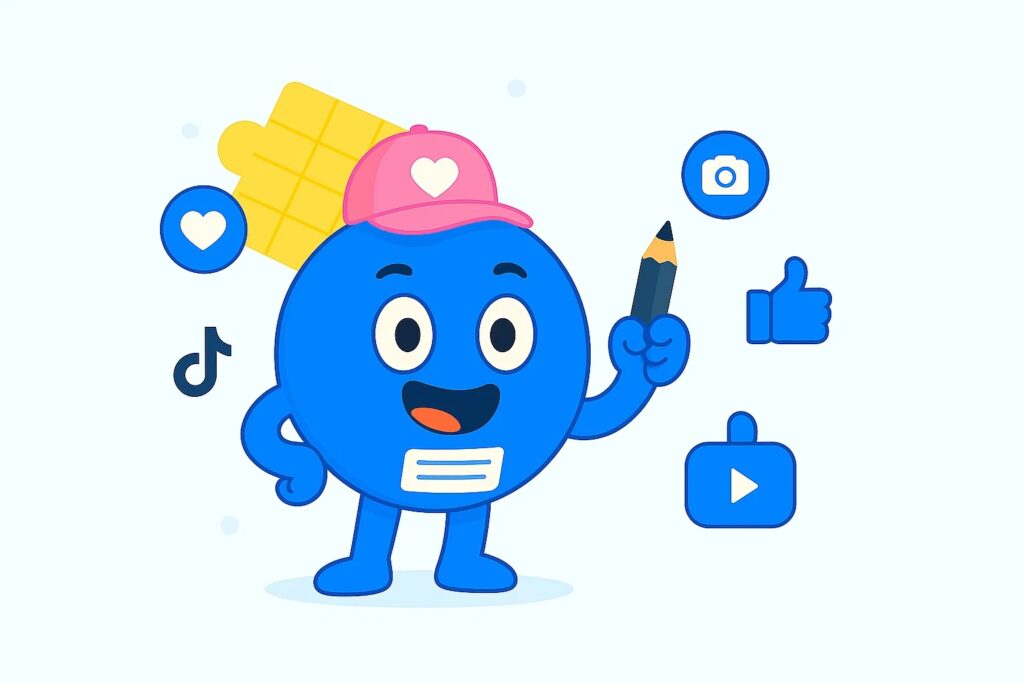
Beyond mere information delivery, truly effective blog content captivates readers, fostering a loyal and engaged community.
Solving Problems and Sharing Actionable Tips
Effective blog content identifies a problem that the target audience struggles with and provides a clear, step-by-step solution. This focus on actionability and problem-solving offers immediate value to readers, making them more likely to trust the blogger’s expertise and return for more.
Compiling lists of tips, tools, and techniques, presented with scannable bullet points, makes information easily digestible and practical. Similarly, addressing common questions within the industry or niche provides helpful answers and advice.
Offering resources such as free tools, downloads, or checklists further enhances the value proposition. Content that solves problems and provides clear steps is highly shareable, as readers are inclined to recommend practical solutions to their peers.
Using Visuals to Enhance Engagement
In the fast-paced digital environment, visuals are indispensable for capturing and retaining audience attention. Incorporating high-quality images, videos, infographics, and other visual elements helps break up large blocks of text, making content more appealing, easier to digest, and memorable.
These visual aids are crucial for simplifying complex topics and stimulating emotional responses. For a business blog, engaging visuals contribute to higher time on page and lower bounce rates, which are positive signals for search engine optimization.
V. Accelerating Growth: Promoting Your Blog Effectively
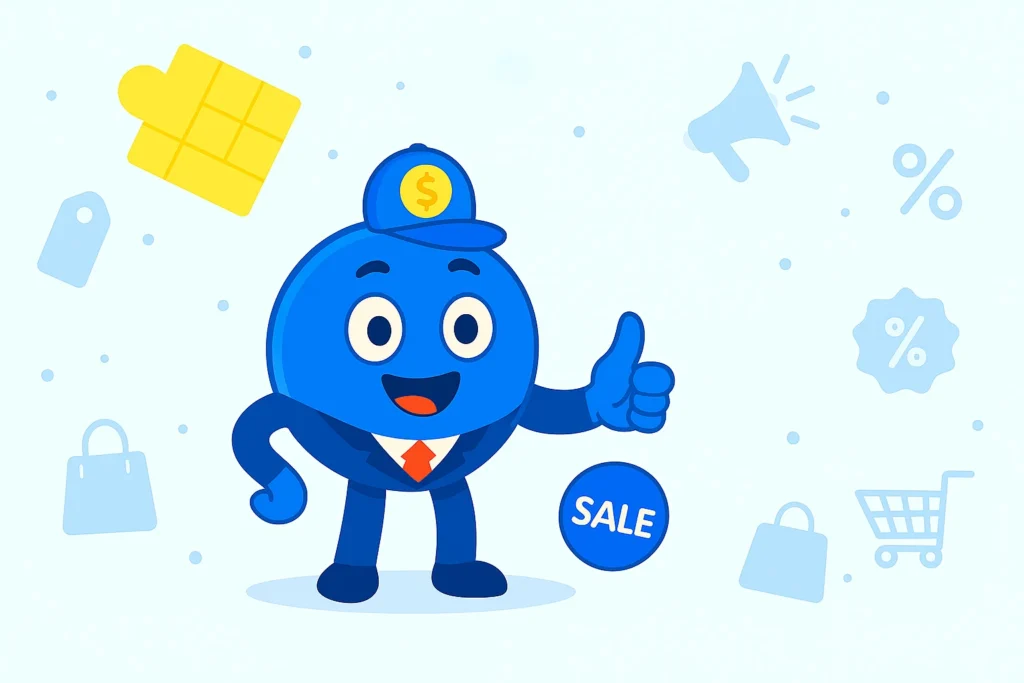
Creating exceptional content is only one part of the equation; getting that content seen by the right audience is equally vital, especially when time is a constraint. This section explores multi-channel promotion strategies to maximize reach.
Multi-Channel Content Promotion
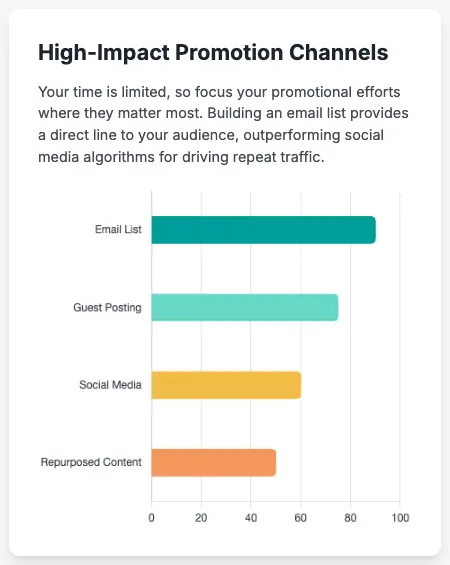
Leveraging Social Media for Reach and Engagement
Sharing content on social media platforms is a fundamental promotion strategy. For busy individuals, the temptation to be present on every social media channel can be strong but is often counterproductive. A more strategic approach involves selecting one or two platforms where the target audience is most active and where the blogger naturally enjoys engaging, then focusing efforts on excelling there.
Building an Email List and Launching a Newsletter
Building an email list and launching a newsletter is a highly effective promotion strategy.
Unlike social media, an email list provides a direct, owned communication channel, free from the whims of algorithm changes. For a business owner, this is invaluable for nurturing leads, announcing new products or services, and driving repeat traffic back to the blog.
Forms for newsletter sign-ups can be integrated directly into the website to facilitate list growth. An email list represents a long-term asset that cultivates a loyal and engaged audience, making it a highly efficient and reliable promotion strategy for busy individuals.
Guest Posting and Collaborating with Other Bloggers
Guest posting on other relevant blogs and collaborating with fellow bloggers are powerful strategies for accelerating growth. These activities allow a blogger to tap into existing, established audiences, rather than building one from scratch. This is a highly efficient growth strategy, as it provides valuable backlinks (improving SEO) and direct exposure to potential new readers, thereby accelerating growth beyond what could be achieved in isolation.
Enhancing User Experience and Conversions with Floating Awesome Button

The Floating Awesome Button (FAB) WordPress plugin is a powerful tool designed to elevate a blog’s functionality and drive desired actions, even when time is limited.
Consider a common scenario: visitors scroll endlessly through a website, searching for contact information, a specific product, or a newsletter signup form. Important calls to action often get lost within the content, leading to missed opportunities and frustrated users.
Now, imagine a transformed experience: with a strategically placed Floating Awesome Button (FAB), the most critical actions are always visible and accessible, regardless of where visitors are on the page. This is akin to having a helpful assistant guiding them precisely to what they need, effortlessly boosting engagement and conversions.
What is Floating Awesome Button (FAB)?
Floating Awesome Button (FAB) is a free WordPress plugin specifically designed for creating original sticky floating action buttons. These buttons “float” on a website’s corner and remain in place as users scroll down the page. FAB is highly customizable, allowing for the display of various content types, including embeds, social media links, shortcodes, widgets, and external links.
The plugin aims to enhance website recognition, introduce originality, and configure user-friendly navigation. It is designed to be intuitive, requiring “zero coding” for implementation.
Key Features & Benefits for Business Owners
The Floating Awesome Button offers a range of features that provide significant advantages for business owners:
| Feature Area | Before Floating Awesome Button (Common Challenges) | After Floating Awesome Button (Desired Outcomes) |
| Call to Action (CTA) Visibility | CTAs buried in content, requiring scrolling; low click-through rates. | CTAs always visible, leading to higher engagement and conversions. |
| Customer Service Access | Contact information hidden on a separate page; slow response times. | Instant access to WhatsApp, email, phone, etc.; improved customer support. |
| WooCommerce Sales | Featured products get lost; lack of urgency for offers. | Key products always visible; pop-up sales alerts create urgency. |
| Affiliate Marketing | Affiliate links blend in, easily missed; lower click rates. | Eye-catching, persistent affiliate links; increased click-throughs. |
| User Navigation | Visitors struggle to find key sections; higher bounce rates. | Seamless, intuitive navigation; enhanced user experience. |
| Lead Generation | Newsletter forms/promos easily overlooked; missed sign-ups. | Prominent forms/pop-ups for newsletter/membership; increased lead capture. |
Practical Use Cases
- For a WooCommerce Store: A floating button can be used to feature a “Product of the Week” or to link directly to a flash sale category. A quick contact button can also be added for immediate customer support inquiries.
- For an Affiliate Marketer: A floating button can link to a “Top 5 Recommended Products” page or a specific high-converting affiliate offer, ensuring visibility regardless of user scrolling.
- For a Service-Based Business: An “Book a Free Consultation” button can be implemented, or a “Download Our Service Guide” pop-up can be triggered for lead generation.
- For a Content Creator: A Floating Awesome Button can serve as a prominent “Subscribe to Newsletter” button or provide quick social media sharing links for the latest posts.
VI. Monetizing Your Blog: Turning Passion into Profit
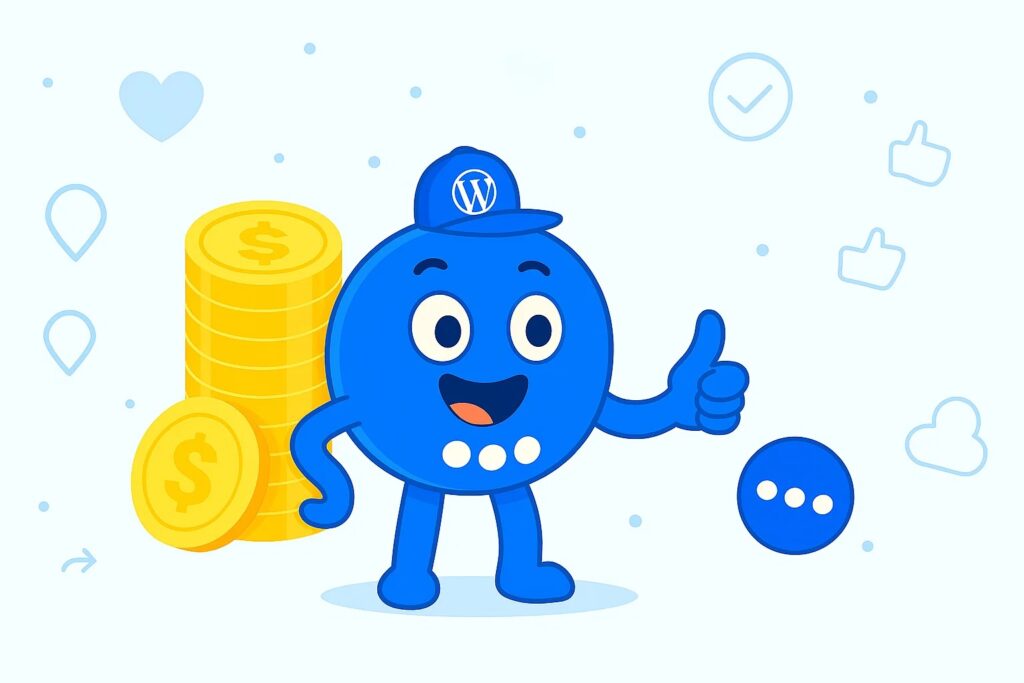
Monetizing a blog while working full-time requires strategic planning and the adoption of sustainable income streams that align with a busy schedule.
Sustainable Monetization Strategies for Part-Time Bloggers
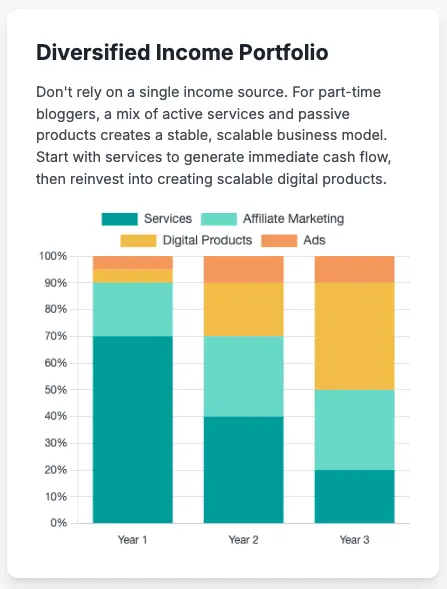
Affiliate Marketing: Authentic Recommendations That Earn Commissions
Affiliate marketing involves promoting products or services and earning a commission for every sale or referral generated through unique affiliate links. This strategy is most effective when the blogger has personally used and had success with the product, allowing for authentic recommendations.
Authenticity is paramount in affiliate marketing; inauthentic promotions erode trust, leading to lower engagement and conversions over time. For busy bloggers, time is too valuable to promote products they do not genuinely believe in. By only recommending products that are genuinely used and loved, credibility is maintained, which forms the foundation for consistent affiliate income and a loyal audience.
If you’re interested in learning more about affiliate marketing and how to increase your affiliate revenue, you can go to this article : Unlock More Sales: How Floating Action Buttons Can Skyrocket Affiliate Revenue
Selling Digital Products (eBooks, Courses, Templates)
Creating and selling digital products such as eBooks, printables, online courses, and templates is an excellent monetization strategy. The primary advantage of digital products is their scalability and potential for passive income; once created, they can be sold indefinitely without requiring continuous active input. This makes them highly attractive for individuals with limited daily hours, allowing them to leverage their expertise efficiently.
Offering Services (Coaching, Consulting, Freelance Writing)
For many new bloggers, offering services like coaching, consulting, or freelance writing is often the most immediate and fastest way to generate income from their blog. By establishing expertise through consistent content, a blogger can leverage their platform to attract clients for one-on-one services. This allows for direct income generation from existing knowledge and helps build a reputation, which can then fund further blog development or digital product creation.
Display Advertising and Sponsored Content
Display advertising, through networks like Google AdSense, offers a passive income stream. Sponsored content, on the other hand, involves creating content that seamlessly promotes a sponsor’s products or services. To attract sponsors, a blog needs demonstrated website traffic and a sizable audience that aligns with the sponsor’s target customer.
While display advertising provides passive income, it comes with a trade-off: user experience. Overwhelming an audience with ads can lead to higher bounce rates and reduced engagement. For busy bloggers, this necessitates a strategic choice: prioritize user experience if the primary goal is building a loyal audience for future product or service sales, or accept the user experience trade-off if maximizing ad revenue is the main objective. This delicate balance is crucial for long-term sustainability.
Setting Realistic Monetization Goals
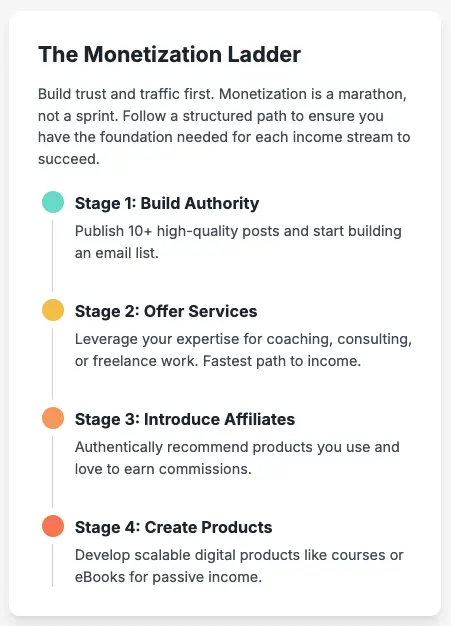
When to Start Monetizing
It is generally recommended that a blog has published at least 10 articles, is actively growing an email list, and is seeing consistent increases in website traffic before actively pursuing monetization. For many new bloggers, the immediate goal is financial return. However, evidence suggests that monetization is more effective as a later stage of blog growth.
Attempting to monetize too early, before establishing a solid content base, audience, and traffic, can be demotivating and yield minimal returns. For busy individuals, this implies focusing initial efforts on consistent content creation and audience building, as these are the necessary prerequisites for successful and sustainable monetization.
Balancing Income Streams with User Experience
A critical consideration for long-term profitability is the balance between maximizing revenue and maintaining a positive user experience. For a business owner, a short-term gain from aggressive monetization might lead to long-term audience erosion.
Prioritizing user experience, even if it means slightly less immediate revenue, cultivates a loyal audience that is more likely to engage with content, share it, and eventually convert into customers for higher-value products or services. This approach ensures the blog remains a sustainable and valuable asset over time.
VII. Conclusion: The Path to Blogging Success
Embarking on a blogging journey while managing a full-time career requires a strategic, disciplined, and adaptable approach. The path to success is paved with careful niche selection, smart time management, the creation of engaging content, simplified SEO practices, proactive promotion, and diversified, authentic monetization strategies.
The evidence suggests that consistent effort is paramount for long-term blogging success. It is a marathon, not a sprint, and continuous learning and adaptability are crucial. With consistent practice and the formation of effective habits, the process becomes progressively easier and more integrated into one’s routine.
It is also important to acknowledge the demands of a busy life and to allow for flexibility, understanding that prioritizing well-being is sometimes more important than rigid adherence to a schedule.
The key message for aspiring and current bloggers is to simply begin. Take that first step, however small it may seem. The blogging journey is iterative; it involves learning from experiences, adapting strategies, and continuously refining the approach. Each step forward, no matter the size, represents progress toward building a thriving and profitable online presence.


